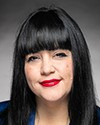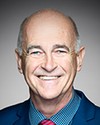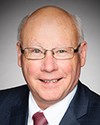Thank you, Mr. Riddell.
I want to come back to my earlier question about needs.
Mr. Temple and Mr. Hauknes, taking into account your respective areas of expertise, what are your priorities when it comes to salmon?
Evidence of meeting #24 for Fisheries and Oceans in the 43rd Parliament, 2nd session. (The original version is on Parliament’s site, as are the minutes.) The winning word was hatcheries.
A video is available from Parliament.
Bloc

Marilène Gill Bloc Manicouagan, QC
Thank you, Mr. Riddell.
I want to come back to my earlier question about needs.
Mr. Temple and Mr. Hauknes, taking into account your respective areas of expertise, what are your priorities when it comes to salmon?
Capt Josh Temple
Thank you, Mrs. Gill.
As I mentioned earlier in one of my responses, certainly starting with habitat restoration would be the top priority from my perspective.
I'll give an analogy very quickly. None of us would expect to plant a productive garden if the soil were contaminated or full of rocks. We have to look at the garden first. The garden for salmon, as I understand it from a first nation perspective, is not healthy at all, and we know this to be true. We have to first rehabilitate the habitat if we expect to have any meaningful chance of recovery.
I will leave some time for the rest of the witnesses.
Liberal

The Chair Liberal Ken McDonald
Thank you for that, Madame Gill.
We will now go to Mr. Johns for two and a half minutes or less, please.
NDP

Gord Johns NDP Courtenay—Alberni, BC
Thank you, again, to all the witnesses for their important testimony.
Captain Temple, can you speak about how important coastal British Columbians' restoration work is for COVID-19 job recovery and about the opportunity that it presents right now given the state of wild salmon?
Capt Josh Temple
That's a really important question, and it's one that I hoped somebody would ask. Mr. Hauknes touched on this, on what we do with loss of economic activity through fishermen and through COVID-19. Creating jobs and creating meaningful employment opportunities and contract opportunities for first nations and coastal communities through this type of restoration work, particularly in coastal communities that have suffered so greatly from losses of fisheries opportunities and forestry, are critical to rebuilding our coastal economies.
I think that it's a two-pronged approach. Not only are we making meaningful progress in aiding the recovery of salmon, but we're also creating much-needed jobs, particularly in remote coastal communities here in British Columbia that have suffered so greatly through not only COVID-19 but also the loss of access to productive fisheries, forestry and other such industries that we used to traditionally depend on here on the coast.
NDP

Gord Johns NDP Courtenay—Alberni, BC
Can you touch a bit on the importance of the partnerships that you have with indigenous communities and how the local indigenous guardian programs, for example, could be mobilized to do some of this work?
Capt Josh Temple
Yes, absolutely. It's a very large aspect of our fundamental philosophy in our Coastal Restoration Society to support local first nations in any of the projects that we work with. Really, with sometimes tens of thousands of years of traditional knowledge in these local environments, there is no better source of information and science to turn to in terms of how best to manage our local resources over time.
If we can somehow find a way to collaborate more effectively between first nations by utilizing their guardian programs, their hereditary leadership and their traditional ecological knowledge experts and marrying that with our more traditional western science and leadership and management perspectives, I think we are going to achieve far greater results than we have seen in the past. I think that is a pathway that we all need to endeavour to engage to walk together on.
Liberal

The Chair Liberal Ken McDonald
Thank you, Mr. Johns. You were right on the button that time. That was great.
We'll now go to Mr. Calkins, please, for five minutes or less.
Conservative

Blaine Calkins Conservative Red Deer—Lacombe, AB
Thank you.
I'm now going to ask questions of Dr. Riddell.
We've met before, as I'm sure you recall.
Conservative

Blaine Calkins Conservative Red Deer—Lacombe, AB
I want you to talk a little bit about this, notwithstanding Captain Temple's assertions that it doesn't make sense to build up hatchery capacity without having the habitat in place. I think you and I had a frank conversation, and could you remind me of what your thoughts might be about the department's current...I'm not going to say attitude but a word that might be synonymous with attitude.... Towards community-based hatcheries, whether those hatcheries are there for scientific use, for stock replenishment or for restoring breeding stock, is the department actually respecting the knowledge of the local community hatcheries and using them adequately, or could that be improved?
Science Advisor, Pacific Salmon Foundation, As an Individual
Well, I think it could be improved, but I mean hatcheries can have very different objectives. The major hatcheries that the salmon enhancement program has built were built to provide fish to commercial fishing and also to recreational fishing as they changed the species composition. They were not built to be conservation hatcheries, right?
Community-based hatcheries can be very effective, just the way Josh referred to them. You can return some spawning populations by having localized community hatcheries. Also, maybe you don't do work in one stream only through the community. You could have several streams alternating through time.
You really have to be clear on the objective of your hatchery before you really look at what's being done and what could be done. I think there's great opportunity in providing the diversity by using more community-based hatcheries. The push-back you get is that they can be more expensive, because you need to have more trained staff and more widely diversified facilities and so on. Or, you could build larger facilities again, but use “satelliting”, as we used to call it, where you could bring in different populations and move them back out to their home streams. I think we've learned so much about salmon genetics, physiology and genomics that we could use hatcheries in a much more directed way. That would be different than just producing large numbers of fish.
Conservative

Blaine Calkins Conservative Red Deer—Lacombe, AB
Agreed, but moving to a conversation on large numbers of marked fish, then, because your answer was a perfect segue into my thoughts, several groups, whether it be sport fishing groups or others, are arguing that right now the chinook retention closures and so on are having a devastating economic impact on some businesses on the west coast. They argue that they could move to a marked selective fishery right away, given the fact that there are so many marked fish in the system from outside of Canada.
Canada, in that agreement, marks only a certain percentage, a very small percentage, especially of chinook salmon. Would you agree with their assessment that we should move to full marking of chinook hatchery salmon and move to marked retention fisheries? Would that be something that would be viable not only for the sport fishing industry? Could that be something that we could get a first nations involvement in with not only the hatchery production but also the retention for food, social and ceremonial uses on marked salmon and almost run a parallel marked salmon versus wild salmon fishery to protect wild salmon stocks?
Science Advisor, Pacific Salmon Foundation, As an Individual
Well, unfortunately, what we're talking about here really is a mix of biology, sociology and cultures. This is not a straightforward thing that you should do this, yes or no. You could certainly do elements of this, and I have been promoting the consideration of mass marking, because I think to sustain our coastal communities and to have viable tourism and recreational fishing, we need to provide opportunity.
You can't just have closures, because you're going to lose the resource; you're going to have loss of infrastructure, etc. The decision has to be for the rebuilding of the natural populations that have conservation needs. Is there a sustainable level of harvest or mortality that could be sustained while you do that? You'll have to make a very explicit management decision that you will enable a limited mortality in order to sustain communities while you rebuild the populations.
Rebuilding is not going to be overnight. It could take 10 to 20 years, so you have to have a long-term perspective about our communities as well. It will have to be limited; it is not a panacea. If we think that the allowable harvest is 5% of a return—and it could be that low—then the scale of the fishery you can provide is going to be limited.
We can know these things; we can identify animals to their stream of origin and that, so we can do the assessments. It's a matter of how open we are to looking at a new way of doing these analyses and rebuilding. We need to think long term. We need to think about wild fish, but we have to consider our communities, I think, to make it saleable in the long term.
Liberal

The Chair Liberal Ken McDonald
Thank you, Mr. Calkins.
We'll now go to Mr. Hardie for five minutes or less, please.
Liberal

Ken Hardie Liberal Fleetwood—Port Kells, BC
Thank you, Mr. Chair.
Captain Temple, as you listened to Dr. Riddell's comments about hatcheries, you mentioned that there are streams and perhaps inlets where there used to be salmon and there aren't anymore. Could you visualize community-based hatcheries basically restoring populations to some of these waterways?
Capt Josh Temple
That's an excellent question, and in fact, we do have community hatcheries in place here in Clayoquot Sound and Barkley Sound that were set up to specifically augment runs that were in serious and troubling decline.
Those hatcheries have been operating at a fraction of their capacity—again circling back to a lack of appropriate funding or sufficient funding. These hatcheries are here; they're ready to go with experienced staff in place, like Mr. Doug Palfrey here at the Tofino salmon enhancement facility. The thing I hear year after year is that they're inadequately funded, so unfortunately, we're not maximizing them to their ability.
Liberal

Ken Hardie Liberal Fleetwood—Port Kells, BC
I'm going to put some words in your mouth here. Would you agree that sometimes it's not just the dollars that it takes to get an operation up and running, but that there are other considerations like the social one, and the availability of food eventually when they come back? In other words, we shouldn't necessarily just be fixated on how much it costs to do something, but that we need to look at a whole range of essential elements that would make something like this really worthwhile.
Capt Josh Temple
Absolutely. Again, it harkens back to our reliance on dependable and thorough science—as Dr. Riddell would reinforce, I'm sure. However, in the situations where we have a near or complete extirpation of salmon, there has to be some form of augmentation to restart or rekindle that run. In many cases throughout the regions I'm personally intimately familiar with, in the areas where I've fished and worked over the course of my career, there are facilities that could easily contribute to the rebound of those systems, but they're suffering from a lack of funding in almost every case.
Liberal

Ken Hardie Liberal Fleetwood—Port Kells, BC
Dr. Riddell, I'll go back to you for a second. I want to go back to some of your earliest commentary. In the work that you were doing in two of the four phases of that initiative, you mentioned that you were studying the arrival or presence of various pathogens in the salmon population. Do you have any sense of timing as to when some of those may have all of a sudden become factors? In particular, is there a connection you could draw from the data between the arrival of pathogens and the arrival of aquaculture on the west coast?
Science Advisor, Pacific Salmon Foundation, As an Individual
We've only really investigated at that degree of detail for one virus, and that was the piscine orthoreovirus. It's the one that's been in the media many times, related to the heart and skeletal muscle inflamation disease. We have done a very careful genetic study of its origin, where it's from, and whether it's being exchanged with salmon farms.
That research is the basis for my answering to a previous question that yes, the assessment of the Pacific Salmon Foundation and the strategic salmon health initiative is that there is more than minimal harm and that the PRV's origin is in the European Atlantic area. We believe it came over approximately 30 years ago. That, by coincidence, puts it in close relationship to the development of salmon aquaculture.
In this one instance, then, in which we've been able to do this study, it does actually unfold in that way.
Liberal

Ken Hardie Liberal Fleetwood—Port Kells, BC
We've heard in other studies that the Pacific Salmon Foundation has done an awful lot of work up and down the coast. I believe it was the Nass River system that was the focus of a complete assessment by the Pacific Salmon Foundation.
If that is the case and my memory is correct, what is the state of the runs in the Nass versus the runs in the Fraser River, given that the Nass certainly hasn't seen the kind of human activities that we've seen along the Fraser River?
Science Advisor, Pacific Salmon Foundation, As an Individual
I'm not sure what you're referring to from PSF in the Nass. We've not done that. If there was such a study, it was a very old review.
There are many factors involved with this, because the Nass Valley is also very much less developed. There's a huge difference there, to start with.
Unfortunately, the Nass supports the concern about climate change and changes in the ocean, because the productivity coming back to the Nass right now is depressed compared with their recent averages—with one exception: in 2020, they had a very good chum return.
This is the challenge of Pacific salmon. You get these outliers, all of a sudden, that are really good or really bad. Overall, the Nass is very consistent with the Skeena, southeast Alaska, central Alaska, in that there is a declining production.